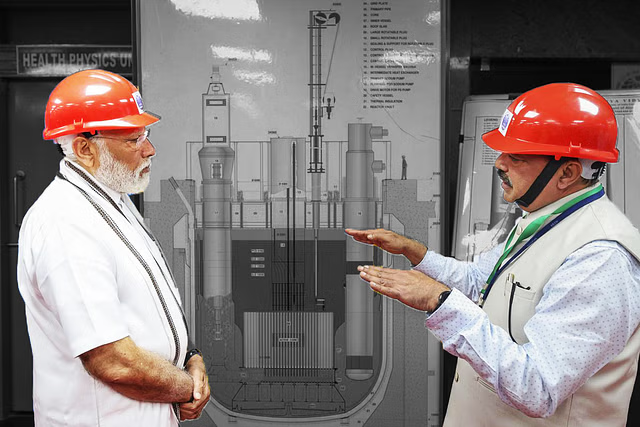Context:
Prime Minister witnessed the commencement of “Core Loading” at India’s first indigenous Prototype Fast Breeder Reactor (PFBR) (500 MWe) at the Madras Atomic Power Station in Kalpakkam, Tamil Nadu.
Key Details
- In the spirit of Aatmanirbhar Bharat, PFBR is indigenously designed and constructed by Bhartiya Nabhikiya Vidyut Nigam Ltd (BHAVINI).
- Over 200 Indian industries, including MSMEs, contributed to its construction.
- The reactor utilizes Uranium-Plutonium Mixed Oxide (MOX) fuel initially.
- Utilizes Uranium-238 “blanket” for nuclear transmutation, creating more fuel.
- Future plans include using Thorium-232 as a blanket for transmutation into Uranium-233 for the third stage of the program.
- PFBR has advanced third-generation reactor technology with inherent passive safety features.
- It aims for a significant reduction in nuclear waste generation and comparable capital and operational costs.
About BHAVINI
It was incorporated in October 2003 with the objective of constructing and commissioning the first 500 MWe Fast Breeder Reactor (FBR) at Kalpakkam in Tamil Nadu and to pursue construction, commissioning, operation and maintenance of subsequent Fast Breeder Reactors for generation of electricity.
How does the PFBR work?
Pressurized heavy-water reactors (PHWRs) use natural or low-enriched U-238 as the fissile material and produce Pu-239 as a byproduct. This Pu-239 is combined with more U-238 into a mixed oxide, which is then loaded into the core of a new reactor along with a blanket. The blanket is a material that the fission products in the core react with to produce more Pu-239.
A breeder reactor is designed to produce more fissile material than it consumes. In a “fast” breeder reactor, the neutrons are not slowed down, allowing them to trigger specific fission reactions.
Significance
- Upon completion of core loading, the reactor will approach criticality, leading to subsequent power generation.
- The reactor offers a safe shutdown mechanism in case of emergencies.
- It promises to effectively utilize India’s abundant thorium reserves.
- After its commissioning, India will become only the second country, after Russia, to operate a commercial Fast Breeder Reactor.
- The growth of India’s nuclear power program is essential for national energy security and aligns with global efforts towards sustainable development.
India’s 3-Stage Nuclear Programme
Homi Bhabha envisioned India’s nuclear energy programme in three stages to suit the country’s low uranium resource profile and to utilize huge thorium reserve in India.
1. First Stage:
- Utilizes natural uranium (U235 + U238) as fuel in Pressurized Heavy Water Reactors (PHWRs) and produces Plutonium-239 as a byproduct.
Natural uranium contains only 0.7% of the fissile isotope Uranium-235.Most of the remaining 99.3% is Uranium-23 which is not fissile but can be converted in a reactor to the fissile isotope Plutonium- 239. - Heavy water (deuterium oxide, D2O) is used as a moderator and coolant.
- PHWRs currently form the backbone of India’s nuclear power generation.
2. Second Stage:
- Fast Breeder Reactors (FBRs) employed.
- FBRs use a mixed oxide (MOX) fuel made from Pu239 (recovered by reprocessing spent fuel from the first stage) and natural uranium.
- FBRs breed more fuel (Plutonium-239) than they consume by converting Uranium-238 present in MOX into additional Pu239.
- It aims at achieving self-sufficiency in fuel supply and utilization of thorium reserves.
3. Third Stage:
- Advanced nuclear reactors designed to use Uranium-233 fuel obtained from Thorium.
- Thorium-232 undergoes neutron absorption to produce fissile Uranium-233. Intended to fully utilize India’s abundant Thorium reserves for long-term energy sustainability.
- KAMINI (Kalpakkam Mini reactor) is a research reactor at IGCAR. It is the world’s only thorium-based experimental reactor and is fueled by Uranium-233 metal produced by the thorium fuel cycle harnessed by the PFBR (Prototype Fast Breeder Reactor).


